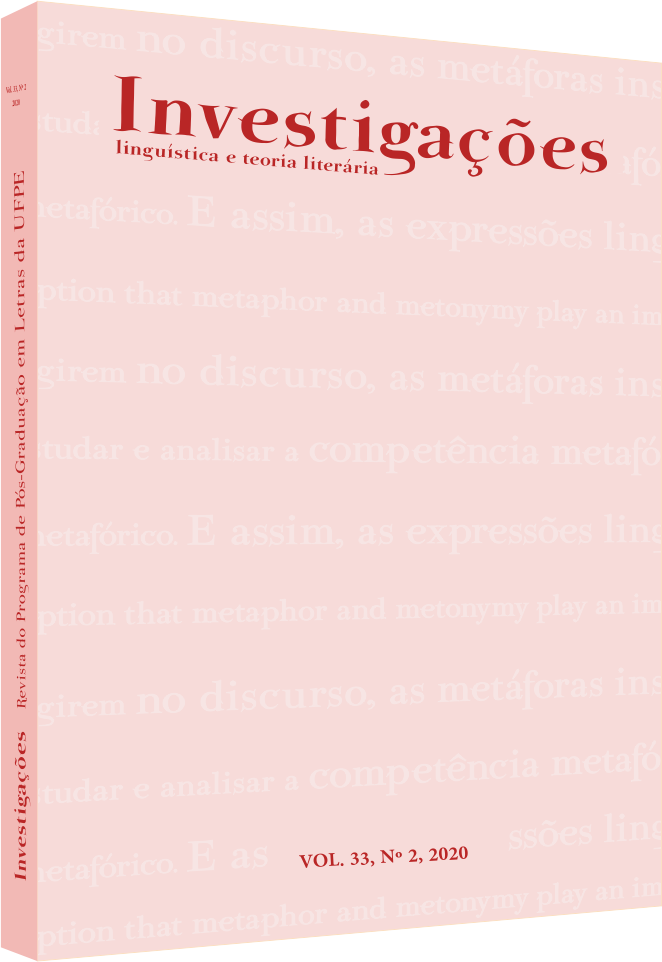Marcação Diferencial do Objeto direto (DOM) em kimwani, uma língua bantu
DOI:
https://doi.org/10.51359/2175-294x.2020.241749Palabras clave:
marcación del objeto directo, afectación, lLengua bantu, Kimwani.Resumen
Describimos y analizamos el patrón de marcación de los objetos directos en Kimwani. Describimos la tipología de DOM y presentamos evidencias de que la DOM no está relacionada con la escala o el grado de afectación, sino por la jerarquía de relevancia del objeto: los rasgos [+ humano] y [+ animalidad] están en el punto más alto dela jerarquía, y requieren marcación diferencial en la posición de objeto directo. Este resultado apunta a una dirección contraria de la propuesta teórica de Dowty (1991) con datos del inglés, Hopper y Thompson (1980) y Nᴂss (2004) con datos de varios idiomas.Citas
AIKHENVALD, Alexandra Y. Verb types, non-canonically marked arguments and grammaticalrelations: ATariana perspective. 2001. In: ALEXANDRA Y. Aikhenvald R.M.W. Dixon & MASAYUKI Onishi. (edits). Non-Canonical Marking of Subjects and Objects. Pp. 177-200. John Benjamins Publishing Company. Vol. 45. Amsterdam/Philadelphia. 2001.
AIKHENVALD, A. Y. ‘‘Warekena’’. In: Handbook of Amazonian Languages, Vol. 4, D.C. Derbyshireand G. K. Pullum(eds). Berlin: Mouton de Gruyter. 1998a, Pp- 215–439.
ALEXANDRA Y. Aikhenvald R.M.W. Dixon & MASAYUKI Onishi. (edits). Non-canonical Marking of Subjects and Objects. John Benjamins PUBLISHING Company. Vol. 45. Amsterdam/Philadelphia. 2001.
BLEEK, Wiherm. A Comparative Grammar of South African Languages. London: Trübner. 1862.
COMRIE, Bernard. Aspect. Cambridge:Univesity Press.1976.
COMRIE, Bernard. Aspect. Cambridge: Cambridge University Press. 1998.
CHOMSKY, N. and HALLE, M. The sound pattern of English. New York: Harper and Row. 1968.
DIXON, R. M.W. Ergativity. Cambridge: Cambridge University Press. 1994.
AIKHENVALD, A. Y.. Grammatical relations in Tariana. Nordic Journal of Linguistics17: 201–18. 1994.
AIKHENVALD, A. Y.. The Semantic Basis of Sintactic properties. BLS 10, 583- 595.
DOWTY, David R. Thematic proto-roles and argument selection. Language:547-619. 1991.
GIVÓN, Talmy. Typology and functional domains. Studies in Languages 5.163-193. 1981.
GUTHRIE, Malcolm. Comparative Bantu: an introduction to the comparative linguistics and prehistory of the Bantu languages. 4 vols. Letchworth UK & 276 Brookfield VT: Gregg International.1967/71.
HOPPER, P.J. & THOMPSON, S. A. Transitivity in gramar and discourse. Language 56.251-299. 1980.
JAKOBSON, R. Zur Struktur des russichen Verbums. In Charisteria. G. Mathesio. Prague: Cercle Linguistique de Prague. 1932. Pp. 74-84.
LAZARD, G. Le marquage diférentiel de l´objet. 2001. In: Language typology and language universals: An international handbook, M. Haspelmath, E; König, W. Oesterreicher and W. Raible (edits.). Berlin: Mouton de Gruyter. 2001.
LEVIN, B. Objecthood: an event structure perspective. CLS 35, volume 1: The Main Session, 1999.
LEVIN, Beth and HOVAV, Malka Rappaport. Research Sueveys in Linguistics, Argument Realization. Cambridge University Press. 2005.
MARI, Broman Olsen and PHILIP, Resnik. Implicit Object Constructions and the (In)transitivity Continuum. In: 33rd Proceedings of the Chicago Linguistic Society, 1997.Pps 327–336.
MARTIN, Haspelmath. Non-canonical marking of core arguments in European languages. In: ALEXANDRA Y. Aikhenvald R.M.W. Dixon & MASAYUKI Onishi. (edits). Non-Canonical Marking of Subjects and Objects. Pp. 53-83. John Benjamins Publishing Company. Vol. 45. Amsterdam/Philadelphia. 2001.
MEINHOF, Carl. Introduction to the Phonology of the Bantu Languages. Berlim: Dretrich Reimer,1932.
NÆSS, Ǻshild. What markedness marks: the markedness problem with direct objects. Língua 114. 1186–1212. 2004. disponível online: www.sciencidirect.com
MOROLONG, MALILLO, & HYMAN, L. Animacy, objects, and clitics in Sesotho. Studies in African Linguistics 8; 199-217.1977.
NGONYANI, Deografia. Properties of Applied objects in Kiswahili and Kindendeule; Studies in African Linguistics, Volume 27, Number 1, spring 1998.
NGUNGA, Armindo. Introdução à Linguística Bantu. Imprensa Universitária. UEM. Maputo, 2004.
ONISHI, Masayuki. Introduction: Non-canonically marked subjects and objects:Parameters and Properties. In: ALEXANDRA Y. Aikhenvald R.M.W. Dixon & MASAYUKI Onishi. (edits). Non-Canonical Marking of Subjects and Objects. Pp. 1-52. John Benjamins Publishing Company. Vol. 45. Amsterdam/Philadelphia. 2001.
“Autor”, . Tom gramatical em kimwani. Dissertação de Mestrado. Universidade Pedagógica de Moçambique. 2016.
SITOI, Bento e Ngunga, Armindo (Org). II Seminário sobre a Padronização da Ortografia de Línguas Moçambicanas, NELIMO, UEM. 2000.
TRUBETZKOY, N. S. Grundzuge der Phonologie. Travaux du Cercle Linguistique de Prague 7. 1939.
Descargas
Publicado
Cómo citar
Número
Sección
Licencia
Derechos de autor 2020 Calawia Salimo, Marco Antonio Rocha Martins

Esta obra está bajo una licencia internacional Creative Commons Atribución 4.0.
Autores que publicam na Revista Investigações concordam com os seguintes termos:
Autores mantêm os direitos autorais e concedem à revista o direito de primeira publicação, com o trabalho simultaneamente licenciado sob a licença Creative Commons Atribuição 4.0 Internacional (CC BY 4.0) que permite o compartilhamento do trabalho com reconhecimento da autoria e publicação inicial nesta revista.
Autores têm autorização para assumir contratos adicionais separadamente, para distribuição não-exclusiva da versão do trabalho publicada nesta revista (exemplo: depositar em repositório institucional ou publicar como capítulo de livro), com reconhecimento de autoria e publicação inicial nesta revista.
Qualquer usuário tem direito de:
Compartilhar — copiar e redistribuir o material em qualquer suporte ou formato para qualquer fim, mesmo que comercial.
Adaptar — remixar, transformar e criar a partir do material para qualquer fim, mesmo que comercial.
O licenciante não pode revogar estes direitos desde que você respeite os termos da licença.
De acordo com os termos seguintes:
Atribuição — Você deve dar o crédito apropriado, prover um link para a licença e indicar se mudanças foram feitas. Você deve fazê-lo em qualquer circunstância razoável, mas de nenhuma maneira que sugira que o licenciante apoia você ou o seu uso.
Sem restrições adicionais — Você não pode aplicar termos jurídicos ou medidas de caráter tecnológico que restrinjam legalmente outros de fazerem algo que a licença permita.

